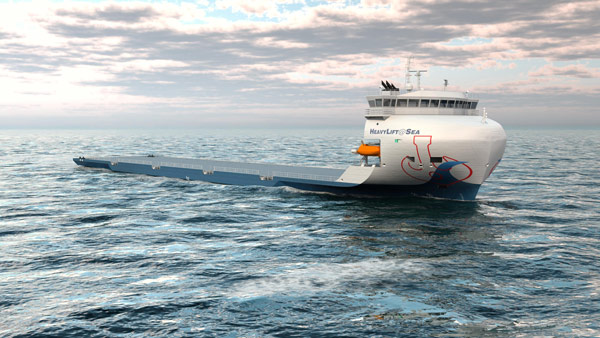
Bespoke design for heavy cargo deck carrier

Rendering of the DP2 vessel
The bespoke design, formulated by Hamburg maritime engineering firm HeavyLift@Sea, incorporates a range of innovative features required for the vessel’s initial operation by a Hamburg-based shipping company specialising in offshore wind projects in the North and Baltic Seas.
The heavy deck cargo carrier – DC 10000 – is designed for the shipment of heavy cargoes, large modules and components that cannot easily be lifted owing to their weight or structure. The vessel is designed so that heavy cargoes like these can be rolled onto the loading deck which has a large area in relation to the size of the vessel. The 148.5m-long ship has a breadth of 28m, a deck area of 3,600m2 and a total load capacity of 10,000 tonnes.
Apart from the large deck, the DP2 vessel has various other innovative design features. Since the ship’s initial operation will require calling at a small port in Denmark, dimensions were a key consideration during the design process. The HeavyLift@Sea team therefore simulated these parameters at the Danish shipbuilding test facility in Copenhagen to achieve a satisfactory result.
Hendrik Gröne, the ship designer’s managing director, explained: "The ship will initially transport wind power components for offshore wind turbines. There were a number of requirements that seemed to be mutually exclusive at first. The width of the required cargo deck had to be reconciled with a ship width that was small enough for the approach to this particularly small Danish port. At the same time, in order for the ship to pass through the Kiel Canal, it had to be taken into account that the deck couldn’t be wider than the waterline."
The large deck has been made possible by a very compact superstructure and deckhouse with accommodation for 21 people. The deck itself has a high load-bearing capacity, both for general and point loads, that provides flexibility when transporting heavy goods and offshore components. This will provide added flexibility for the ship’s operation after its first deployment in the seas around northern Europe.
"We also designed the ship to meet the shipping company’s needs for flexible worldwide deployment and maximum utilisation of such a special vessel," Gröne said, pointing out that the ship’s advanced dynamic positioning arrangements make it suitable for operation in complex offshore projects worldwide.
The DNV GL-classed vessel has diesel-electric propulsion to provide good manoeuvrability, with generators under the aft deck arranged in an unconventional way to support energy efficiency. The propulsion system, which provides a speed of about 12 knots, exceeds current environmental requirements and incorporates a selective cataltytic reduction system for exhaust gas cleaning. The vessel is due for delivery at the end of 2019.
The HeavyLift@Sea team, based at Veritaskai in Hamburg, is now working on the design of a special ship for offshore wind operations.
